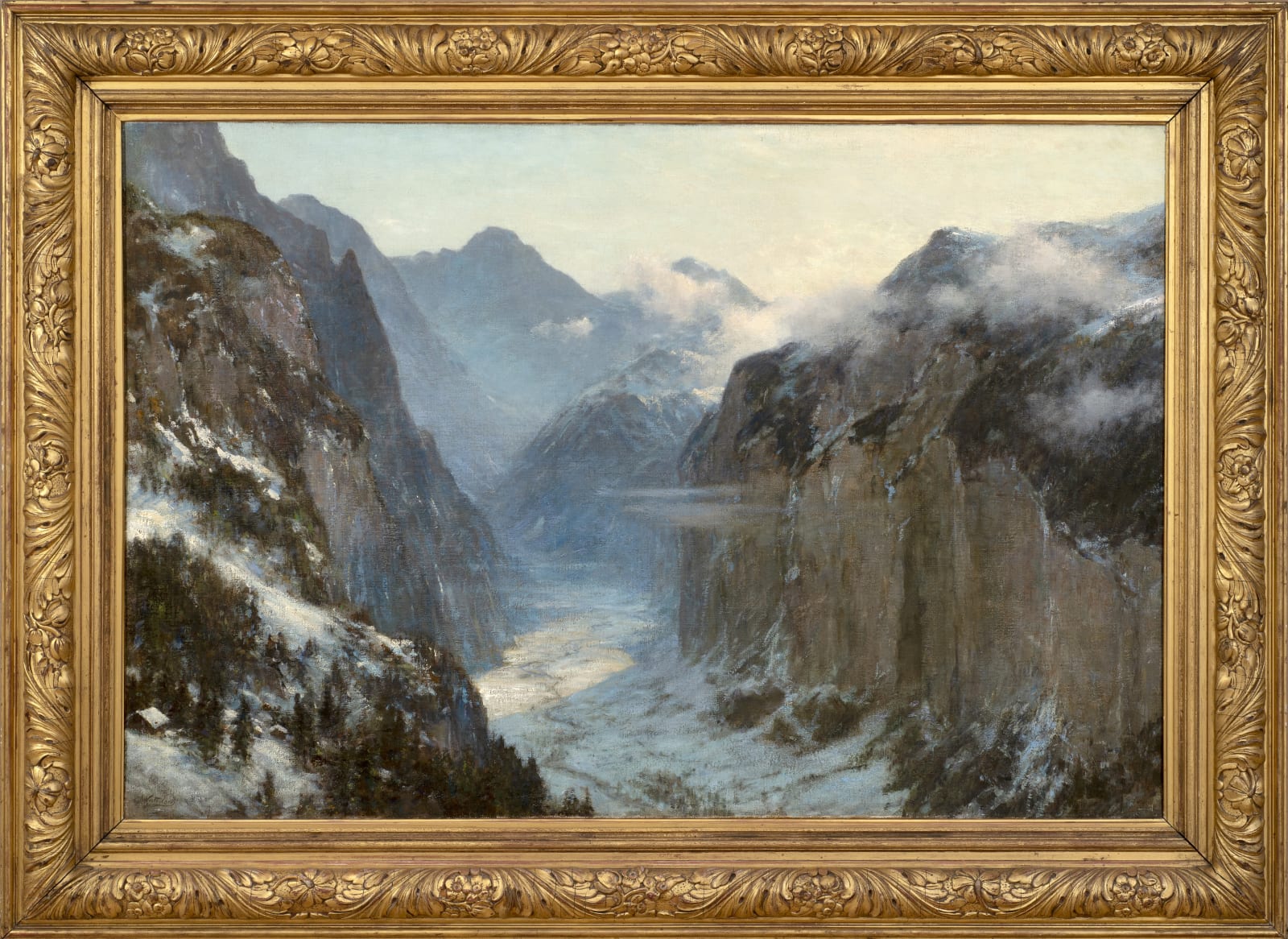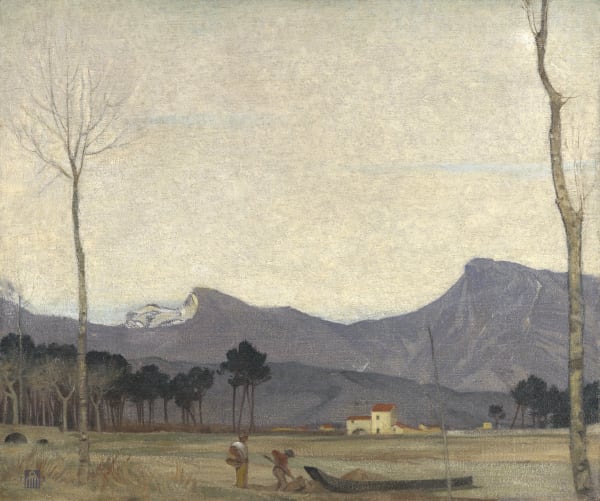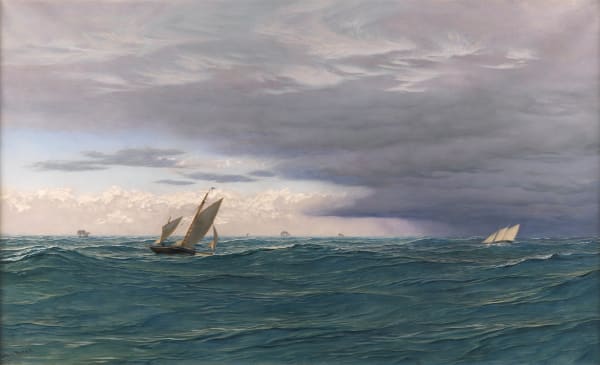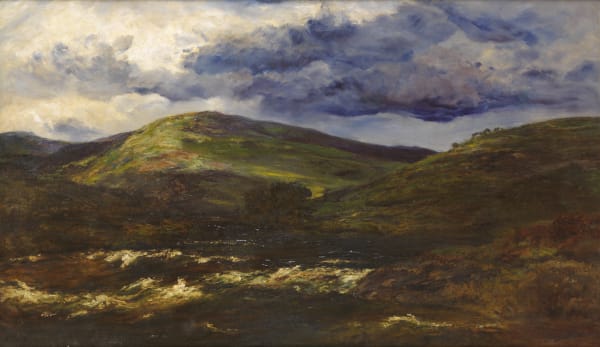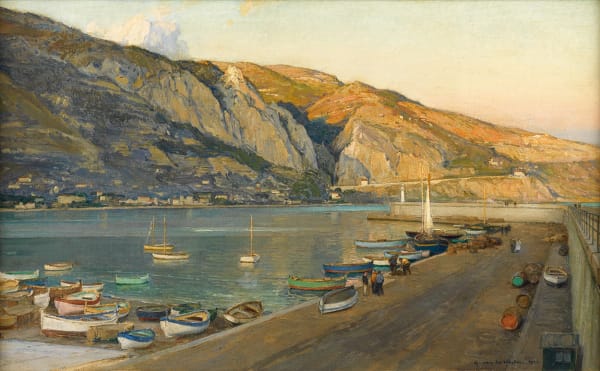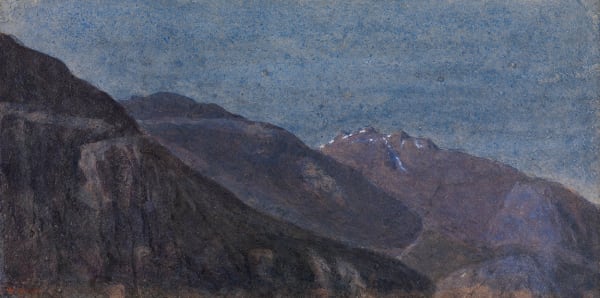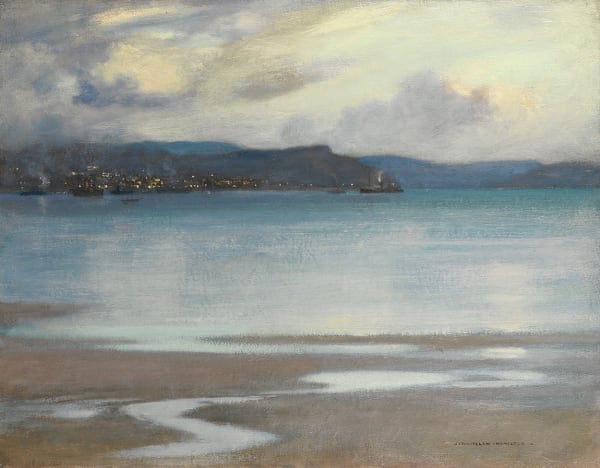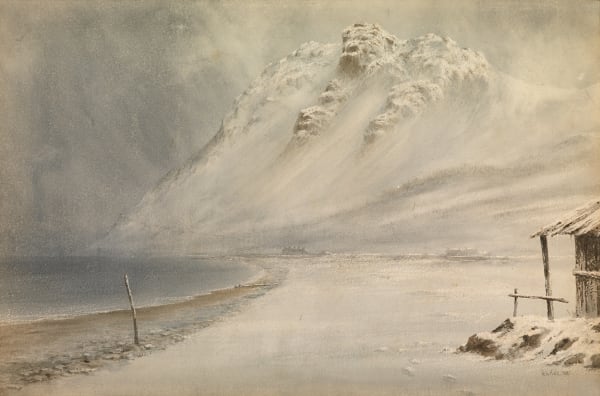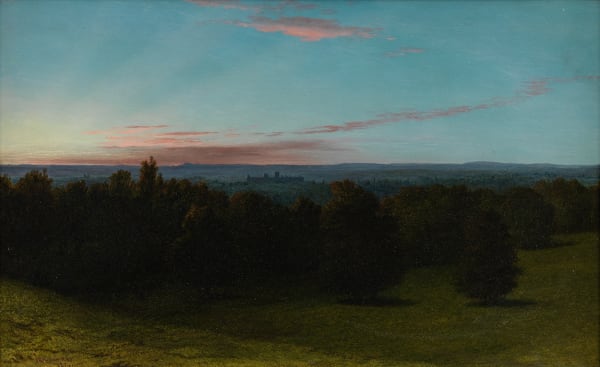Ernest Albert Waterlow (1850-1919)
Provenance
Purchased from the Royal Academy 1916, in the purchaser's family until 2003;
Christie's London, September 2007, lot 262;
Peter Nahum at Leicester Galleries, c. 2006;
Bemberg Collection
Exhibitions
Royal Academy, 1916, no 376
Royal Academy, 1920, no 811
Literature
Royal Academy Pictures and Sculpture, 1916, London, 1916, illustrated p 140
This dramatic picture, shown at the Royal Academy in 1916, is of the Valley of Lauterbrunnen (‘loud waters’) in Switzerland’s Bernese Oberland, a place suffused with myth and ancient lore, which inspired generations of artists. The cliffs rise over 200m and over 60 waterfalls cascade over them from such a height that they disperse into mist before they hit the ground. It is morning, and the sun is in the east, casting deep shadows into the depths below. The Staubbachfall and the Spissbachfall are prominent on the east side of the valley, and the view is from a stop on the Wengernalp cog railway, the locomotives of which wind themselves over the west cliffs just above the village of Wengen, behind you, and opposite the village of Mürren on the east cliffs. ‘Majestic impressions are created especially when one of the great peaks approaches the edge of the tabletop to look down and suddenly reveal its full height above the valley’, wrote Ruskin of the Eiger (he visited in 1866). The Breithorn is the highest mountain in the background, with the Tschingelhorn behind clouds on the right. The Valley has been a rich source of inspiration to Romantic poets, painters and musicians for hundreds of years. A visit to the Staubbachfall in October of 1779 inspired Goethe to write his poem Gesang der Geister über den Wassern (‘Song of the Spirits over the Waters’), which compares the mystical journey of the soul to the cycle of water. In the particularly freezing winter of 1816 (the ‘Year without a Summer’ exactly 100 years before our painting was exhibited at the RA in the darkest year of the First World War), Byron, accompanied by his personal physician John William Polidori, was staying at the Villa Deodati on Lake Geneva with Percy and Mary Shelley. Their famous ghost-story sessions gave rise to two Gothic literary landmarks, Mary Shelley’s Frankenstein and Polidori’s The Vampyre, and Byron’s tour that same year up the Lauterbrunnen valley inspired his dramatic poem Manfred. Staying at Wengen, Byron noted in his Alpine Journal, 1816: ‘[A] range of scenes beyond all description, or previous conception … the clouds rose from the opposite valley, curling up perpendicular precipices like the foam of the ocean of hell during a spring tide.’ Of the Staubbachfall, he wrote that it resembled ‘the tail of the pale horse ridden by Death in the Apocalypse.’ This passage in Manfred (Act I, Scene II) inspired two other English paintings, one by John Martin in 1832, and another by Ford Madox Brown in 1842:
... And you, ye crags upon whose extreme edge
I stand, and on the torrent’s brink beneath
Behold the tall pines dwindled as to shrubs
In dizziness of distance, when a leap,
A stir, a motion, even a breath, would bring
My breast upon its rocky bosom’s bed
To rest for ever – wherefore do I pause?
… Thou winged and cloud-cleaving minister,
Whose happy flight is highest into heaven,
Well may’st thou swoop so near me …
… How beautiful is all this visible world!
How glorious in its action and itself!
Manfred and its spectacular setting also inspired several Romantic composers, including Schubert, Schumann and Tchaikovsky. In 1911, the 19 year old JRR Tolkein went on a summer holiday to the Valley of Lauterbrunnen, a trip that he recollected vividly in a letter in 1968, noting that Bilbo’s journey across the Misty Mountains (‘including the glissade down the slithering stones into the pine woods’) is directly based on his adventures as their party of 12 hiked up to camp in the moraines beyond Mürren. Tolkien recaptured Lauterbrunnen, a precipitous Alpine valley, in drawings and paintings of the elf fastness of Rivendell, and echoed its name in the English and Elvish names of Rivendell’s rivers: Loudwater and Bruinen. The nearby Silberhorn was ‘the Silvertine (Celebdil) of my dreams’, he said, referring to one of the three Misty Mountain peaks above the dwarven Mines of Moria. The title of Waterlow’s painting is from Psalm 95. It was exhibited at the RA with several other mountain pictures by him. Our picture was noticed in the West Sussex Gazette, 25 May 1916: ‘an impetuous torrent forcing its way through a deep and rocky ravine; a delightful work.’ Another, of a similar view, The Mantle of Winter, may be the picture now in Shipley Art Gallery now titled Winter in the Lauterbrunnen Valley, Switzerland, of the same dimensions, showing the Jungfrau mountain more prominently to the left. It was presented to Gateshead by Lady Waterlow, described by her as ‘one of the artist’s favourite works’.
-
 Charles Sykes (1875-1950)The Rainbow, 1944£12,000
Charles Sykes (1875-1950)The Rainbow, 1944£12,000 -
 Edward Clifford (1844-1907)Saas-Fee, Switzerland£650
Edward Clifford (1844-1907)Saas-Fee, Switzerland£650 -
 Maxwell Ashby Armfield (1882-1972)Viareggio, TuscanyPOA
Maxwell Ashby Armfield (1882-1972)Viareggio, TuscanyPOA -
 John Brett (1831-1902)Yachts in a Seaway, MediterraneanPOA
John Brett (1831-1902)Yachts in a Seaway, MediterraneanPOA -
 James Lynch (b. 1956)Nadder Valley£12,000
James Lynch (b. 1956)Nadder Valley£12,000 -
 Theodore Howard Somervell (1890-1975)The Himalayas, near Tinki Dzong£6,500
Theodore Howard Somervell (1890-1975)The Himalayas, near Tinki Dzong£6,500 -
 Henry Moore (1831-1895)Glen Orchy, Storm coming onPOA
Henry Moore (1831-1895)Glen Orchy, Storm coming onPOA -
 Harry van der Weyden (1868-1952)The Harbour at Menton, Côte d'Azur£6,000
Harry van der Weyden (1868-1952)The Harbour at Menton, Côte d'Azur£6,000 -
 George Price Boyce (1826-1897)The Ticino Valley from Giornico£7,800
George Price Boyce (1826-1897)The Ticino Valley from Giornico£7,800 -
 James Thomas Watts (1849-1930)A World of Snow and Cloud£8,500
James Thomas Watts (1849-1930)A World of Snow and Cloud£8,500 -
 James Whitelaw Hamilton (1860-1932)Evening on the ClydePOA
James Whitelaw Hamilton (1860-1932)Evening on the ClydePOA -
 George Lothian Hall (1825-1888)Snowstorm at Penmaenmawr, North Wales£3,200
George Lothian Hall (1825-1888)Snowstorm at Penmaenmawr, North Wales£3,200 -
 John Rogers Herbert (1810-1890)Near Llangollen, North Wales£8,200
John Rogers Herbert (1810-1890)Near Llangollen, North Wales£8,200 -
 Freda Marston (1895-1949)The Maritime Alps, near Alassio£4,800
Freda Marston (1895-1949)The Maritime Alps, near Alassio£4,800
The Maas Gallery, 6 Duke Street, St. James's, London, SW1Y 6BN
+44 (0) 20 7930 9511 | mail@maasgallery.com
This website uses cookies
This site uses cookies to help make it more useful to you. Please contact us to find out more about our Cookie Policy.

